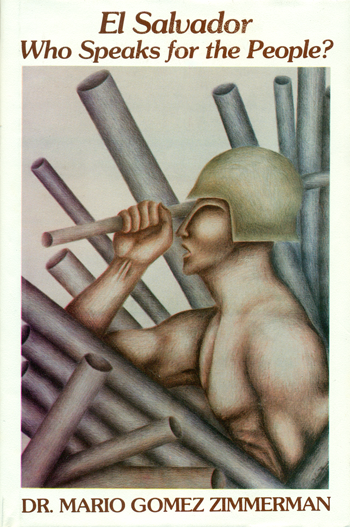El Salvador
Who Speaks for the People?
 Prior to Power to the West!, Dr. Mario Gómez-Zimmerman realized that he had to strive to counteract the disinformation on the civil war of El Salvador, as it was spread by the left-wing intellectuals. Such conflict was portrayed as one between powerful right-wing elites bound to preserve their privileges, and an exploited people. Such portrait was not totally false, for no one can deny the abuses and corruption that prevailed before the war. Yet, the resulting lack of justice and benefits for the general population was much exaggerated, as the lack of responsibilities by the general population was totally ignored, for example irresponsible parenthood, which accounted very much for its grim situation. But the fact that most interested the left-wing establishment to hide, was that behind the demands of changes—which most of the population justly supported—existed a formal attempt to win El Salvador for the Communist cause. Much more than a revolution, what was going on in that country was an instance of the Soviet expansionism, as it had happened in Cuba and in Nicaragua.
Prior to Power to the West!, Dr. Mario Gómez-Zimmerman realized that he had to strive to counteract the disinformation on the civil war of El Salvador, as it was spread by the left-wing intellectuals. Such conflict was portrayed as one between powerful right-wing elites bound to preserve their privileges, and an exploited people. Such portrait was not totally false, for no one can deny the abuses and corruption that prevailed before the war. Yet, the resulting lack of justice and benefits for the general population was much exaggerated, as the lack of responsibilities by the general population was totally ignored, for example irresponsible parenthood, which accounted very much for its grim situation. But the fact that most interested the left-wing establishment to hide, was that behind the demands of changes—which most of the population justly supported—existed a formal attempt to win El Salvador for the Communist cause. Much more than a revolution, what was going on in that country was an instance of the Soviet expansionism, as it had happened in Cuba and in Nicaragua.
That is why, when the people realized what was the ultimate goal of the guerrillas and which would be its consequences, they withdrew their support for the insurgence. All this is shown in the books El Salvador, la otra cara de la Guerra, and El Salvador, Who Speaks for the People?, along with many other aspects of the conflict. Despite the relative simplicity of their approach by the author at such times, he puts us in contact with the war praxis of the left and with truths ignored by the most of the media: the kidnappings of innocent people, the destruction of the economy in order to generate uprisings by famine, the preaching of social class hatred by priests aligned with the liberation theology. That and many more—although never ignoring or excusing the abuses and crimes committed by what became known as the right—make clear that the only choice for any person responsible before the historical challenge against freedom, and committed with the defense of genuine human rights, was the same made by the people of El Salvador, the one which allowed to defeat for the first time the all-out Communist expansionism in America.
© 1993–2011 Mario Gómez Zimmerman. All rights reserved.
Investigaciones Objetivistas Trascendentales
(En preparación)
The Capitalist Structures of Hinduism
Este artículo fue pubicado por el Action Institute en la edición de Mayo-Junio de 1996
by Mario Gmez-Zimmerman
The argument that the free market and Christianity are compatible will be strengthened if it can be shown that the same is true for other religions. We will therefore attempt this project using Hinduism as our referent.
In discussing this subject, we must keep in mind two characteristics of Indian culture. First, the typical Western split between the religious and the socio-economic realms is very limited in Hinduism, as it is indeed for most Oriental mentalities; practical social morality is supposed to agree with religious and philosophical precepts. Thus, codes of law which presumably derive from the latter can be regarded as part of Hinduism. Second, as there is no central religious authority to establish orthodoxy, the teachings of recognized spiritual masters are usually incorporated into Hinduism. In addition, let us state that we will refer here mainly to traditional and trans-historical doctrines and practices.